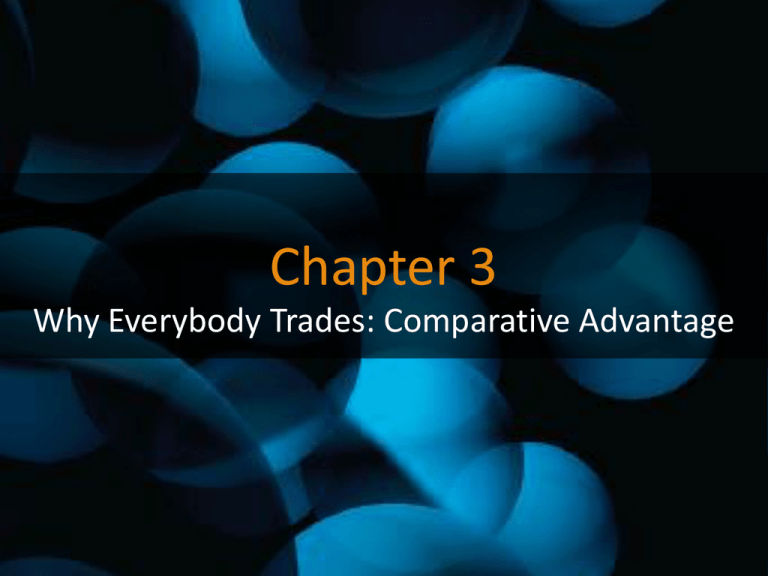
Chapter 3
Why Everybody Trades: Comparative Advantage
Adam Smith’s Theory of Absolute
Advantage
In his Wealth of Nations, Adam Smith promoted
free trade by comparing nations to households.
Every household finds it worthwhile to produce
only some of the products it consumes, and to
buy other products using the proceeds from
what the household can sell to others. The same
should apply to nations.
© 2016 McGraw-Hill Education. All Rights Reserved.
2
Principle of Absolute Advantage
A country is expected to export those goods in which it
has an absolute cost advantage and import goods in
which it has an absolute cost disadvantage
Labor hours to
make:
US
Rest of the World
(ROW)
1 unit of cloth
4.0
1.0
1 unit of wheat
2.0
2.5
© 2016 McGraw-Hill Education. All Rights Reserved.
3
Absolute Advantage
© 2016 McGraw-Hill Education. All Rights Reserved.
4
David Ricardo’s Theory of
Comparative Advantage
• Mutually beneficial trade can occur even when one
nation (say, ROW) is absolutely better at producing
all goods
• Although ROW is absolutely better, the key is relative
prices (or costs) and not absolute prices (or costs) of
products.
• In other words, it is the opportunity cost of
producing each product in each country that will
determine the basis for trade among nations.
© 2016 McGraw-Hill Education. All Rights Reserved.
5
Ricardo’s Theory of Trade
• Comparative advantage
A country will export products that it can produce
at a low opportunity cost (in terms of other goods
that could be produced within the country).
A country will import products that it would
otherwise produce at a high opportunity cost.
• Ricardo focused on labor productivity (or resource
productivity more generally) for different products in
different countries.
Basis for trade: Relative differences in labor
(resource) productivity.
© 2016 McGraw-Hill Education. All Rights Reserved.
6
Comparative Advantage
© 2016 McGraw-Hill Education. All Rights Reserved.
7
Relative Price
© 2016 McGraw-Hill Education. All Rights Reserved.
8
The Ricardian Model
• Hence, U.S. has a comparative advantage in
production of wheat, and a comparative
disadvantage in production of cloth.
• The rest of the world has a comparative advantage
in production of cloth, and a comparative
disadvantage in production of wheat.
• With free trade the U.S. will export wheat and import
cloth.
© 2016 McGraw-Hill Education. All Rights Reserved.
9
Ricardo’s Constant Costs and The
Production-Possibilities Curve
• Production-possibility curve (ppc) shows all
combinations of amounts of different
products that an economy can produce with
full employment of its resources and
maximum feasible productivity of these
resources.
© 2016 McGraw-Hill Education. All Rights Reserved.
10
Ricardo’s Constant Costs and the
Effects of Trade
• With no trade, each nation’s choices for the
consumption of wheat and cloth is limited to a
point along its production possibilities curve.
• With free trade between the two countries, each
country specializes (at point S1) in producing its
comparative-advantage product.
• With free trade consumers in each country can
consume at any point along the new trade line
(for example, at point C) and enjoy a higher
standard of living.
© 2016 McGraw-Hill Education. All Rights Reserved.
11
The Gains from Trade
© 2016 McGraw-Hill Education. All Rights Reserved.
12
Question: Does it make sense for a country to
pursue a policy of self-sufficiency in, for
example, food, or energy? Why or why not?
© 2016 McGraw-Hill Education. All Rights Reserved.
13
Some Implications of the Theory of
Comparative Advantage
• According to the Ricardian model, relative price
differences arise from productivity differences that
are in turn due to exogenous differences in
technology among nations.
• Although comparative advantage determines the
pattern of trade among nations, absolute advantage
is important in determining the income in each
country.
© 2016 McGraw-Hill Education. All Rights Reserved.
14
Does absolute advantage matter?
If free trade is so good, why do so many people
fear it? Activists and protesters have recently
been complaining loudly that trade has bad effects
on
• Workers in developing countries.
• Workers in the industrialized countries.
• The natural environment.
Analysis of absolute advantage and comparative
advantage focuses on a resource called labor, so
let’s focus on trade and workers.
© 2016 McGraw-Hill Education. All Rights Reserved.
15
Does absolute advantage matter?
• A big part of the answer to these questions is that
absolute advantage does matter . But it matters not
for determining the trade pattern but rather for
determining national wage levels and national living
standards .
• Workers can receive high wages and enjoy high living
standards if they are highly productive. Workers with
low productivity are paid low wages.
© 2016 McGraw-Hill Education. All Rights Reserved.
16
Average Labor Productivity and
Average Wage in Manufacturing, 2006
© 2016 McGraw-Hill Education. All Rights Reserved.
17





